Published in: Mushroom - The Journal of Wild Mushrooming Issue 102, vol.27.1, 2009, p.33-40. Tales of the Himalayan Gypsy Wandering between Rozites and Cortinarius emodensis By Daniel Winkler Hoping to catch up with the other landcruiser after having just called a stop to admire and photograph a beautiful patch of deep purple Elephant trunks (Pedicularis siphonantha), I saw two Tibetan youngsters walking with big wicker baskets on their backs on the road just below Yak La Pass. There is a very good chance when seeing people with bags or baskets in the middle of nowhere, in the summer, in Tibet, that these containers are full of mushrooms. I was hesitant calling another stop, as it is very hard to make good distance when you keep on giving in to your curiosity. I could not resist. As it turned out Gumu's and Tashi's baskets were filled with a mass of purple-brownish mushrooms. We quickly learned it wasTertse they were hunting up here in the subalpine fir forest in nearly 4000m (13,200ft). Gumu and Tashi Tsering were at first a quite baffled by our interest in their bounty, we must have been the first foreigners showing interest in their mushrooms. They came quickly around and let us handle and smell their mushrooms. We were about to leave to catch up with the other part of my MushRoaming group, when Tashi Tsering asked us, "Would you like to go with us in the woods to find them yourselves?" First I said, "Sorry no time"; then I thought, Wait a minute, that's exactly why we are here. I was certain that the other part of the group would find a way to make good use of their time along such a gorgeous high alpine pass and we would catch up at some point for sure. 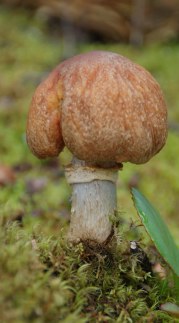 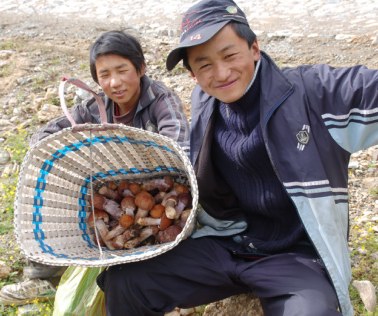 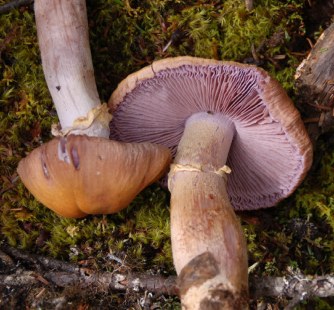 Himalayan Gypsy (Cortinarius emodensis) shown to me by Gumu and Tsering, in NW Yunnan - Pema Karpo / Baima Xueshan, Dechen / Deqin County, Dechen / Diqing Tibetan Autonomous Prefecture, Yunnan, July 2007 © Daniel Winkler We did not have to go more than thirty yards into a forest of rather stunted dark firs. The firs were growing out of a thicket of tall Rhododendron shrubs and mountain ashes, the soft moist ground covered in a thick, luxurious layer of moss. Before I could spot the mushrooms Tashi Tsering pointed out a group of brownish, mid sized mushrooms with slender stems. They looked quite different from what we just had seen in his basket, since these mushrooms had open, sometimes even uprolled caps, displaying rust brown gills and hardly any purple anymore. But these apparently mature specimen clearly exhibited a pronounced annulus, which confirmed my suspicion that we were dealing with the Gypsy mushroom, or rather, a Tibetan version of the Gypsy mushroom. We inquired with the collectors, and many other people, to find out the meaning of Tertse, but nobody knew. A frequent comment was that it is the first mushroom to appear after the onset of the summer monsoon in early July. Gumu and Tashi Tsering also told us that they sell their Tertse catch down in the town of Dechen for 5 Yuan ($0.8) per pound. On the market in the capital of Dechen Tibetan Autonomous Prefecture of Yunnan Province, Shangri-La they sold for 8 Yuan ($1.2) Yes, you read correctly, Shangri-La is the latest name. For many decades during the 20th Century it was also known as Zhongdian and for more than a millennium as Gyelthang, Tibetan for "royal plateau or plains". But back to Dechen, whose name means "supreme bliss", words uttered by the Great 5th Dalai Lama in the 17th Century, when he first saw this place. The name stuck and its original names "Jol" or "Atuntzu" are nearly forgotten, the latter preserved in the name of the beautiful bright blue and slender Gentiana atuntsiensis, which is common around Dechen. For any dedicated mushroomer it is probably not much of a coincidence nor a surprise to hear that we had been served this mushroom just the night before in a restaurant down in Dechen. The mushrooms might have been picked by Gumu and Tashi. We came across the mushrooms in the surprisingly clean kitchen of the restaurant. We often ask waiters if we can go into the kitchen to find out what kind of food is available to help us order our meals. These shiny brownish-purple mushrooms caught my attention right away, but I have to admit in this unopened stage, not displaying its ring, I did not recognize that I was facing a Tibetan version of the Gypsy mushroom. The purple reminded us of Cortinarius, but there was this membrane. Feeling curious we ordered the mushrooms, but ate them with a bit of hesitation since we were not hundred percent sure - strictly from a taxonomic perspective - what we were being served. However, working with rural communities I trust local knowledge and the proper scientific name is in most cases of much lesser importance than the passed down knowledge of the use and edibility of a plant or mushroom. Having said this, I should admit that I have eaten Paxillus involutus in Lhasa before. I would not eat it again, since recent research, which clearly has not filtered down to Tibet, describes the inrolled pax as poisonous, for it can cause in rare cases hemolysis and even kidney failure. Although the Tibetan gypsy mushrooms had a nice texture and pleasant rich fungal aroma, we were much more entranced by the wine we had ordered, which deserved the name wine only due to the fact that it was somewhat fruit based and alcoholic. Its intense sweetness combined with a good dose of fizz suggested that at least a bit of sugar had been added, but we wondered if less benign ingredients had been used. Any ominous symptoms that night would have been challenging to correctly attribute to either the mysterious mushroom or the weird wine. Research regarding the local Tibetan name in Northwest Yunnan brought up several names besides Tertse, of which Ter is most likely a reference to Rhododendron, while the tse could refer to a tip or a point. Another common name in Dechen is Da mo, da meaning Rhododendron, mo short forshamo mushroom. In Kungzera, a Tibetan town down on the Yangtse river between Dechen and Shangri-la, it is called Da mu nuo mu, meaning mushroom (mu) growing under Rhododendron (da) and pine (nuo). A common Chinese names I came across also refers to Rhododendron, Gaoshan dujuan jun, meaning "high mountain Rhododendron mushroom". Often it is just called Gaoshan jun, high mountain mushroom. Dr. Yu Fuqiang also informed me that some people in Shangri-la call R. emodensis also Baipao Jun, but the meaning of Baipao is not so clear, bai is white and paomeans soft or foamy, which could refer to the soft fruiting body. I could imagine the "white & soft" could also refer to the hoary sheen on the unopened caps of young specimen, which are remnants of the universal veil. The Chinese name in Yang's publication on Rozites in China (1999) isxishan luolinsan, meaning Himalaya Rozites, xishan short for ximalaya shan. Yang also describes two varieties, Rozites emodensis var. emodensisand R. emodensis var. vinacea, the latter differing from var. emodensis by being "almost entirely vinaceous to purplish". In Mao's "Macrofungi in China" (2000) it is known as the zizhougai "purple wrinkle cap" Rozites, the true Gypsy mushroom Rozites caperata itself being just "wrinkled". In "Illustration for China Popular Edible Mushroom" (Zhang 1999), the mushroom pictured as Rozites caperata looks awfully similar to R. emodensiswith its purple stipe. Both these Gypsy species are recorded in China although Rozites caperata is found only in the northeast of China, while R.emodensis is distributed in the Himalayas and the southeastern Tibetan Plateau in the northwest of Yunnan, in Western Sichuan and Southeastern Tibet AR (Yang 1998, Mao, Jiang & Otsu 1993). Also listed for this region is Rozites similis. Further research on this colorful mushroom during our MushRoaming tour in July 2007 was impossible. Although, we used Internet cafes in some of the county towns for checking emails and world news, we preferred experiencing life on the streets and in the mountains rather than the virtual connections afforded by the dreadfully slow speed in smoky, grimy Internet cafes mostly populated by "Counter Strike" addicted teenagers. In addition on my trips we routinely come across so much interesting fungi, plants and wildlife that it is really futile to follow up on the road. It is better to take photos and good notes and use winter days at home reliving such impressive experiences. Once home my research into the Tibetan or Himalayan gypsy revealed that, before there was a scientific name for the Himalayan gypsy, Joseph D. Hooker, one of Britain's greatest botanists, and a close friend of Charles Darwin, reports from his expedition to Sikkim in 1849, about his encounter with "a large mushroom" that was "abundant". He also reports that it is well known to his local guide and porters, for whom it is "a favorite article of food". The Bhoteas know it locally as Onglau; in Tibetan it is known as Yungla tchamo. It can be inferred that Hooker might have even eaten the Himalayan Gypsy, since it is mentioned in the context of plants eaten by the locals and Hooker's problems to feed himself and his crew, since much of his supplies needed to be brought in from Darjeeling, which was an arduous twenty-five day hike across extremely steep mountainous terrain. Darjeeling was used by the British as a hill station to escape India's heat and was also used as a "base camp" for exploring the Himalayas and Tibet. Actually, the name Darjeeling is derived from Tibetan Dorje Ling, the "garden (ling) of the thunderbolt or diamond (dorje)"; In Tibetan Buddhism dorje (or vajra in Sanskrit) represents the indestructible nature of absolute reality and, on a more mundane level, Dorje is a common name. In 1849 Joseph Hooker was researching the vegetation of the Eastern Himalayas, botanically speaking an absolute terra incognita at this point, after he had made himself a name by researching the vegetation of New Zealand, the Galapagos Islands and Antarctica. On May 31, Hooker was collecting specimens on the eastern slope of Kangchenjunga (8586m, 28,169 ft), the world's third highest peak, whose original Tibetan name "Kang-chen Zod-nga" means "Great snow of the five treasures", referring to its five main peaks. While botanizing in a pine forest at about 3100m (10,000 ft) altitude in the Lachen Valley, he encountered the Himalayan Gypsy mushroom. Hooker writes that the Reverend Miles Joseph Berkeley, a leading mycologist in 19th Century Britain, named and described it as Cortinarius emodensis based on Hooker's specimens and drawings. Furthermore, he relates that "Mr. Berkeley informs me that the whole vast genus Cortinarius scarcely possesses a single other edible species; he adds that Cortinarius violaceus and C. violaceo-cinereus are eaten in Austria and Italy, but not always with safety". Strangely, Hooker does not mention the Gypsy Cortinarius caperatus, that has been eaten widely, at least in continental Europe, at this point and with whom the Himalayan gypsy shares a membranous annulus and supposedly remnants of an obscure universal veil at the base of its stipe. The Gypsy mushroom was originally described by C.H. Persoon in 1796 as Agaricus caperatus (Back then nearly all gilled mushrooms were classified as Agaricus). Caperatus, meaning wrinkled, refers to the radially corrugated surface of the cap before it opens up and fully extends. Elias Fries transferred the Gypsy mushroom to Cortinarius in 1838, Pier Saccardo to Pholiota. In 1879 Petter Karsten erected the genus Rozites for the Gypsy, but Rozites caperata (Pers.) P. Karst was only hesitantly accepted and many mycologists kept referring to the Gypsy for years to come asPholiota caperata (Pers.) Sacc.. Interestingly, Rozites caperata was reported to have antiviral properties helpful to fight. According to Piraino & Brandt (1999) an extract from the Gypsy mushroom prevented Herpes simplex virus types 1 and 2 from growing in test tubes and it reduced the severity of herpes-related eye disease in mice. It also blocked influenza A, chicken pox and a respiratory virus. The active compound of the Gypsy mushroom is called RC-183 and was patented. Now, to come back to the Himalayan gypsy, in the 1950s Meinhard Moser came across the collection of Hooker's Cortinarius emodensis and realized that he was dealing with two closely related species. Thus, the Himalayan gypsy was renamed to Rozites emodensis (Berk.) M. M. Moser. Furthermore, Moser also included an Australian relative, Rozites australiensis Clel. et Cheel. Many more southern cortinarioid mushrooms seemed to fit nicely into the genus Rozites. From a worldwide total of 18 species, all but 3 were distributed in the Southern hemisphere, where they were mostly associated with the beech family (Fagaceae, in the Southern hemisphere represented by Nothofagus) and Eucalyptus of the Myrtaceae (Bougher, Fuhrer & Horak 1994). Lepp (2006) reports on the very informative Australian Center for Biodiversity webpage, on southern hemisphereRozites species in New Zealand, Argentina & Chile, New Caledonia and in Papua New Guinea. The three northern species were Rozites caperata, R. emodensis and Rozites colombiana, the latter also described with lilac colored lamellae, just like R. emodensis. The Colombian gypsy is known to occur in montane Costa Rica and Colombia, where it is associated with oaks, which are also members of the beech family. In short, a very interesting myco-geographic perspective, and it seemed that in Rozites we had a fungal Gondwanan genus, a fungal match to the famous Podocarpus conifers that are distributed over all former Gondwanan landmasses in South America, Africa, Australia and India. A current distribution of a Gondwanan genus in disjunct continents of the southern hemisphere is explained by a common ancestor before the break-up of Gondwana, the southern half of the former Pangaea supercontinent, in the Jurassic and Cretaceous period. However, not only Pangaea and Gondwana are history, it seems like Rozites is also a memory of the past. Joe Ammirati, a Cortinarius exert from the University in Washington in Seattle warns, "Before one can speculate about Gondwanan origin it is important to know if these species with a membranous annulus form a monophyletic group, have a common ancestor, etc.; They may have nothing to do with the southern hemisphereRozites". Although Rozites as its own genus seemed plausible for over a century, since theses cortinarioid mushrooms have remnants of an universal veil as well as a membranous partial veil, whereas the partial veil of most Cortinarius species consists of a cortina, a "curtain" or cobweb-like veil protecting the gills. In the former Rozites genus, the veil is not cobwebby, but is an actual membrane, that remains after the opening of the cap in the form of a persistent and prominent annulus. The ring was prominent enough to prompt Germans to refer to the Gypsy as "Reifpilz". But the fixation on that membranous partial veil turning into a ring does not help in taxonomy. A recent phylogenetic study (Peintner, Horak, Moser & Vilgalys 2002) on a group of "ringed" cortinarioid species comes to the conclusion that membranous veils have independently evolved several times in the genus Cortinarius, and thus the former genus of Rozites and a few other closely related ones have been absorbed back into the hordes of Cortinarius. Still, a phylogenetic Cortinarius study mostly on European and southern hemisphere species by Garnica et al. (2005) included among 264 Cortinarius the Gypsy and the Himalayan gypsy (C. caperatus & C. emodensis) and the above mentioned C. similis. It turns out that these Gypsies fall into the same clade named Rozites and thus are very closely related. The same fate might happen to their Colombian cousin. Maybe in the future, and here I am wildly speculating, we might have our Rozites back, in case Cortinarius gets split up into manageable genera instead of a super-genus with over 2000 species world wide. Trying to find the first scientific description of Cortinarius emodensis I followed the references from Moser's 1953 article in the Swiss journal of mycology, who quotes Hooker's Journal of Botany from 1851, in1851, in which Berkeley describes the mushrooms collected by Hooker. Luckily, Hooker's Journal is available as a scan on the internet. What pleasure, excitement and convenience to be able to read these original sources on the web! And it is not just scans; one can use the search function on these scanned pdf-files. However, on the page Moser quotes (HJ vol. 2, Berk. Dec. of fungi 1851, p.48) I only find Boletus emodensis, which has a "vivid, strawberry-red cap", and is "densely clothed with downy scales". Sounds like a gorgeous bolete (nowadays Boletellus), but not like a Gypsy. And neither search function nor traditional reading of the whole article by Berkeley reveals a gilled mushroom with the same epithet. This quote turns out to be a dead-end. I finally found the Himalayan gypsy's first description in the Himalayan Journal of 1852 on page 132, where Berkeley describes "Cortinarius (Myxacium) Emodensis". Berkeley includes all the other information Hooker provides in his Himalayan Journals (1854, which are online as part of the Gutenberg EBook Project), from which I quoted above regarding Hooker's first encounter during his expedition in the Himalayas. Moreover, Berkeley mentions the similarity of C. emodensis with C. elatior, the spores "exactly as those of C. elatior", but points out that C. emodensis shares its deflexed ring with C. caperatus. Because the Chinese closed Tibet from March onwards, due to the demonstrations for more autonomy that took place all over the Tibetan Plateau, I did not return for the summer 2008 mushroom season. Most of Tibet remained closed until late June, when the Chinese government was finally finished Olympically torching Lhasa and Mount Everest. However, in September 2009 I was invited to Thimphu, Bhutan, to present my Tibetan research (Winkler 2008, 2008a) on Caterpillar fungus (Cordyceps sinensis) at a conference on Traditional Asian Medicines. I first was hesitant to participate, as the invitation came with only a small grant, just a fraction of the travel costs. However, once I realized the conference was taking place during mushroom season, I knew I had to go. And by now, having studied the first description of Cortinarius emodensis from Sikkim, I was hoping to find out more about the Tibetan gypsy in Bhutan, which is right next to tiny Sikkim and should have the same funga. Although I used to talk about mycota, instead of the awkward fungal flora, now I prefer funga, as it is now used in Europe. It seems to be a far better choice in the context of flora and fauna, which are both derived from Latin whereas mycota is derived from Attic Greek. Furthermore, flora, fauna and funga, also aligns as an alluring alliteration. Before my trip I contacted Dr. Phuntsho Namgyel, who I had corresponded with for many years, since we both worked on fungal resources as source of income for rural communities in High Asia. He had researched Cordyceps sinensis and Matsutake in Bhutan (Namgyel 2003) and had worked on legalizing the collection of Cordyceps in Bhutan. During the conference Phuntsho took me to National Mushroom Center (NMC), just a short walk uphill from the conference venue, and introduced me to his friend Dawa Penjor, the director of NMC. During our first meeting I asked Dawa about Rozites emodensis and he knew right away which mushroom I was talking about, wow! Dawa told me that it is a very popular mushroom and its most common name is Dungshing Shamu, which means "fir mushroom" in Dzongkha [Dzongkha is the official language of Bhutan. It is closely related to Tibetan, but still is a very distinct Himalayan version, which makes clear communication between a Lhasa Tibetan and a Bhutanese difficult.]. It is also collected for the market, where one pound sells for about 100 Ngultrum, (US$2); similarly priced as chanterelles. A few days later I hiked up to Tango Goenba, a monastery not far from Thimphu, Bhutan's capital. The monastery belonged to the Kagyü tradition of Tibetan Buddhism and besides the main shrine rooms built into a 60 degree slope, the mountain was covered with dozens of small satellite huts used by retreatants. A sign told hikers to pass by huts quietly and not to disturb retreat ants' meditation practice. I was hiking with a bunch of Austrians and Swiss researchers, all in Bhutan for the conference and working on Tibetan medicine. Dorji Udon had organized our hike, she is a doctor of Sowa Rigpa, "the knowledge of healing" as Tibetan medicine is referred to in Bhutan. At first the path went slowly up through a tall, dark oak forest with lots of wild gingers, Impatiens and cobra lilies. I had a very hard time keeping up with the group, since there were not just interesting plants, but so many mushrooms. Right in the beginning I spotted a bright orange-brown cluster of something looking awfully like the Big laughing mushroom, Gymnopilus spectabilis, a psychoactive mushroom, growing out of a tree. Some days later over dinner I was told by a Bhutanese that his father used to talk about Ga shamu, the laughter mushroom. This friend of a friend knew that it was an orange mushroom growing on wood that causes lots of laughter after consumption. Unfortunately, I could not question his father and I would not be too surprised if I fed him the information regarding color and substrate. 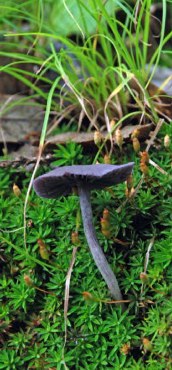 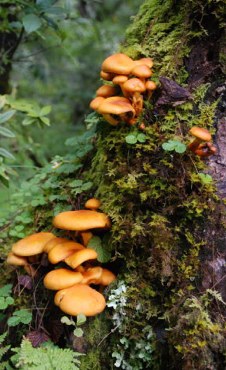 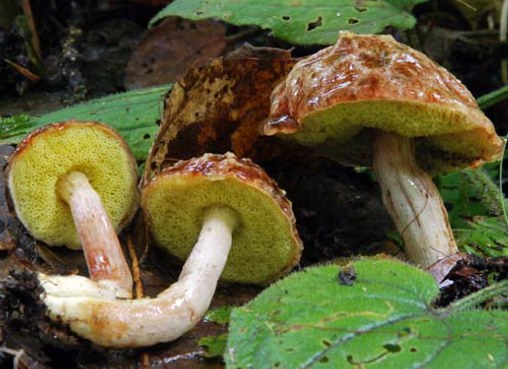 Laccaria amethysta Gymnopilus spectabilis Aureoboletus thibetanus Back in the moist woods, once I had set up my tripod to take a picture of the "Laughing gym", I saw this tiny and slimy, but still very beautiful bolete, an Aureoboletus thibetanus growing out of the oak leaves on the ground. I was familiar with this reticulately capped bolete only from a description, but had never seen it in actuality before. Once I was done with my pictures, the group was gone and I tried hard to catch up. Catching my breath, the 30-pound backpack and already being at 3200m (10'000 ft) strained my lungs then, I discovered a blue purple Laccaria amethysta, or its Himalayan version, what a beauty! I took more pictures, but had to realize there was no way to combine mushrooming and hiking with a group. I told myself I would take pictures on the way down. Luckily the monsoon rains unleashed their daily down pour slowing down the others who stopped to get out rain gear and I managed to catch up, at least with last member of the group. Still, the hike was torture. Not because of the extreme steepness of the path, but because of having to keep up in a forest full of mushrooms. And frankly, we did not have the time to study the mushrooms, since we had to make it up above tree line at 4200m (14,000 ft) before dark. Dorji had arranged for us to use an empty retreat hut for the night. The hut was built on an exposed ridge with a shallow little pond in a bog with an incredible panoramic view of the Himalayan peaks and the Thimphu valley. A few weeks prior the monk who had built the hut, had finished his three-year retreat. A three-year retreat is the most common extensive traditional retreat in the Tibetan Buddhist tradition and having engaged in such a meditational retreat one will be called a Lama, Tibetan for teacher. At lunchtime we were still far below our goal. For lunch Dorji had organized that Wangdi, another monk, who was not in retreat, would cook for us. It was a typical Bhutanese lunch, red rice, ema datsi and shamu datsi. Datsi is a cheese sauce, somewhat close to our idea of a cream sauce, and a Bhutanese favorite. Ema are green chilies. In Bhutan hot peppers are a vegetable, not a spice. Incredible amounts of hot green and red chilies are consumed daily. Not surprisingly, the shamu datsi - mushrooms in cheese sauce - were also fortified with lots of green chilies. Surprisingly, the mushroom cooked was the Himalayan gypsy. 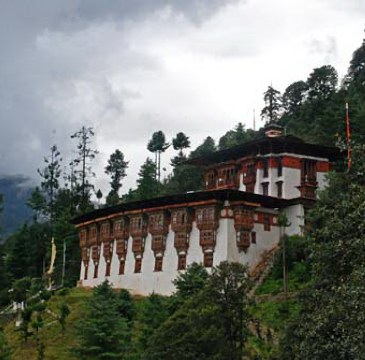 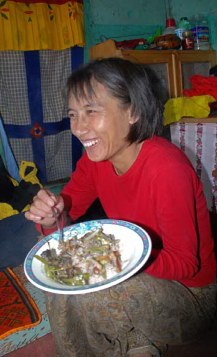 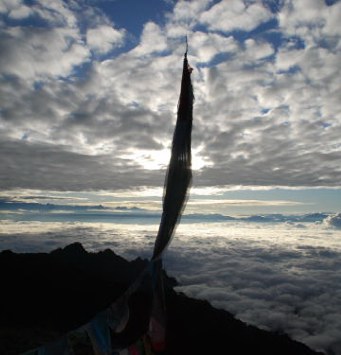 Tango Goenba near Thimphu, Bhutan Dorji enjoying Dungshing Shamu Sunrise above Tango Because the Gypsy fruits with the onset of the rainy season in June in East Tibet, I did not expect it to fruit in Bhutan in September at the end of rainy season. I could still discern the wrinkled cap, which even retained a bit of its pinkish-purple hue. It was difficult to discern its taste beyond pleasantly fungal owing to the overwhelming presence of the green chilies. Still, I had to double check with Wangdi. He confirmed that it wasDungshing shamu. Unfortunately all his mushrooms ended up in small slices in the shamu datsi, so I could not identify the mushroom beyond doubt. I asked Wangdi if he had picked the mushroom himself and if could take me to his hunting grounds. Yes, he had picked them, but he also told me that the patch was too far away and we needed to get going to make it to our destination much further up the steep slope. I kept my eyes peeled uphill and spotted some chanterelles (probably Cantharellus cibarius) in a thick moss layer in a fir-Rhododendron forest. Chanties are highly esteemed and widely traded in Bhutan. They are known as sese shamong or just sisi shamu, the oak mushroom, since it is mostly collected in oak-pine forests. This hike I found no Himalayan gypsy and was very disappointed, since I knew it was somewhere out there in the woods. However, on the way down I could take plenty of pictures since Roland had a very bad knee and could descend only very slowly. When we caught up with Dorji, who had gone ahead to see a patient of hers in the Goenba she excitedly showed me a bag of Dungshing shamu! She had received the mushrooms as gratitude for treating the patient - because health care is free for everyone in Bhutan. She ended up with a tasty dinner and I got to examine the Gypsy, which was a great end to an awesome day. Another day Dawa was so kind as to organize an overnight excursion to Gaynekha, the village where the "first" Matsutake was found in Bhutan. Actually, this mushroom was known before, but in 1988 a Japanese visitor realized that Bhutan's "Po shamu" (penis mushroom), as it was nicknamed back then for its sometimes suggestive shape, was identical with the famous Japanese Matsutake. Everyone now knows it as "Sangay shamu," the Buddha Mushroom, another common name; much better suited for such a highly esteemed mushroom. The next year after this discovery commercial harvest had already started, and ever since then it has been collected in several areas in Bhutan that have warm-temperate oak-pine forests, for export to Japan. But, Bhutan's Buddha mushroom story will be told elsewhere. Back to Gaynekha, Dawa and Phuntsho had arranged to stay the night with a family in a farm house in Zamto village, so we could join in on an early morning Matsutake hunt. Zamto consisted of tall beautiful wooden farmhouses with ornate windows that dotted the hill side surrounded by forested slopes. Once in the farmhouse we were immediately served milk-tea and cookies. This was soon followed by a sumptuous dinner. Once again it included Shamu datsi, clearly an all Bhutanese favorite, and once again the mushroom used in this chili-cheese sauce was Dungshing shamu, the Himalayan gypsy. This really set up my hopes to finally find it myself the next day. Rounds of arak, a clear alcohol, were served, but arak turned out to be the wrong kind of drink to fight the spiciness of the food. We kept talking about the Himalayan gypsy and were told that it is also the very first edible mushroom out in April and May, about the time of morels, which grow too infrequently to be of relevance in Bhutan. We went to bed early, since we were scheduled to rise at 5 a.m. to hunt for Matsutake. 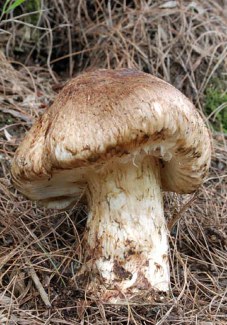 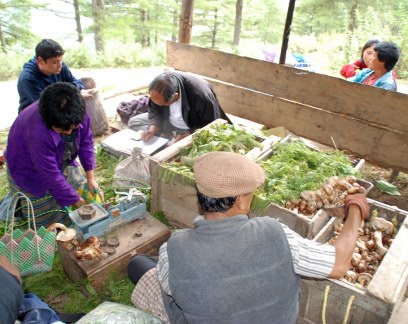 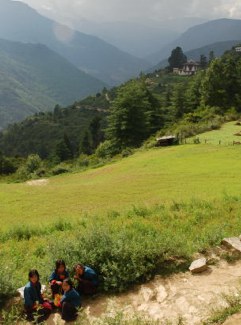 Tricholoma matsutake The Sangay shamu market Gaynekha At dawn, following Dema, the daughter of the family, we went straight up to the evergreen oak (Quercus semecarpifolia) and Bhutan pines (Pinus wallichiana) forest decorated with long strands of Usnea lichen hanging eerily from the branches. It did not take long to find the first mushrooms. Bright yellow chanterelles and a variety of Russula and Suillus dotted the ground. Matsutakes were much more elusive, all we found was a small budding Matsutake. At this point Phuntsho and I had lost sight of Dema and Dawa who went on to find some more Matsutake. The loss of our party was quickly forgotten as I found myself standing in front of several Himalayan gypsy mushrooms in a patch of fallen leaves. What an upstanding, and at the same time delicate mushroom, poking all subtly purple and beige out of dark decaying oak leaves. I first stood in awe but soon got out my short-legged tripod and found myself crawling in the leaves to get my photo just perfect. We picked the young ones, but left behind many older ones, which lose much of their purple complexion. 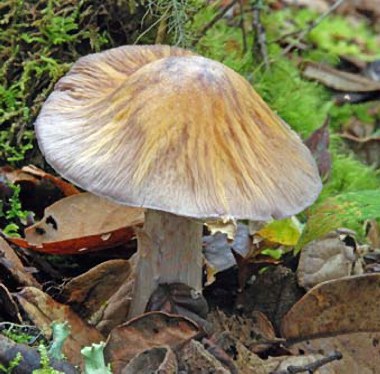 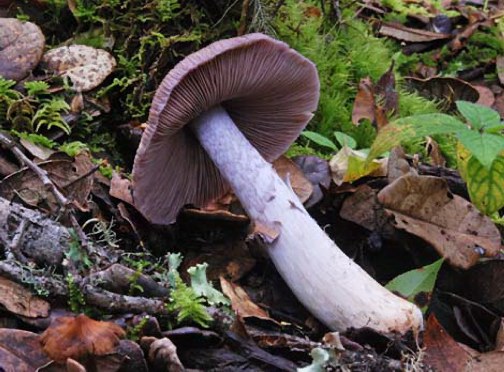 Cortinarius emodensis - The Himalayan Gypsy growing in Bhutan. An attentive reader might have realized (or might even have been annoyed) that my references to this beautiful and tasty mushroom, so much appreciated in the Tibeto-Himalayan region, evolved throughout the article from, at first Tibetan gypsy mushroom, to finally Himalayan gypsy mushroom. I have presented here nearly a dozen local names in four languages and I am sure there are dozens of other local names. Personally, I am still stuck in Rozites for Gypsy mushrooms, since Cortinarius with its globally 2000+ species is already seriously overpopulated, but I am sure I will come slowly around. Still, the scientific name evolved through time from Cortinarius emodensis via Rozites emodensis and finally the circle has closed by going back to its original scientific name of Cortinarius emodensis. For several years I referred to this mushroom as the Tibetan Gypsy, since it was Tibetan people in Yunnan who introduced me to this mushroom. Furthermore, it was first described in the Sikkim-Himalaya and having encountered it in Bhutan, two places clearly in the Tibetan cultural sphere, the name Tibetan gypsy seems quite appropriate. Still, Sikkim and Bhutan are in the Himalayas and the only name unchanging in the taxonomic saga has been the specific epithet emodensis, derived from "Emodi Montes", Latin for the Himalaya mountains, hence Himalayan gypsy sounds just about right. Acknowledgements: Special thanks to Dr. Phuntsho Namgyel, Dawa Penjor and Dr. Dorji Udon for helping me researching the Himalayan gypsy mushroom in Bhutan. For the explanations of the Tibetan names I have to thank Ma Jianzhong, Thubten, Yeshi Gyetsa and Lihua and for helping me with local Chinese names Dr. Yu Fuqiang. For reviewing the taxonomic part I am grateful to Prof. Joe Ammirati. For proof reading I want to thank Larry Evans and especially my wife Heidi Schor. Sources: Berkeley, M. J. 1851. Decades of Fungi XXXII.. Sikkim-Himalayan Fungi collected by Dr. Hooker. In: Hooker's Journal of Botany vol.4: 39-49. Berkeley, M. J. 1852. Decades of Fungi. XXXIX. Sikkim and Khassiya. In: Hooker's Journal of Botany vol.4: 130-142. Bougher, N.L.; B.A. Fuhrer & E. Horak 1994. Taxonomy and biogeography of Australian Rozites species mycorrhizal with Nothofagus and Myrtaceae. In: Australian Systematic Botany 7.4:353-375 Garnica, S. , M. Weiß, B. Oertel & F. Oberwinkler2005. A framework for a phylogenetic classification in the genus Cortinarius (Basidiomycota, Agaricales) derived from morphological and molecular data. In: Canadian Journal of Botany 83.11: 1457-1477. Hooker, J.D. 1854. Himalayan Journals or Notes of a Naturalist in Bengal, the Sikkim and Nepal Himalayas, The Khasia Mountains, etc., Vol. 2. Lepp, H. & M. Fagg 2005. Mycogeography within Australia. Webpages of the Centre for Plant Biodiversity Research Mao Xiaolan 2000. The Macrofungi in China. Zhengzhou, 719p. (In Chinese with Latin names). Mao, Xiaolan; Jiang Changpin; Otsu, Tsewang 1993. Economic Macrofungi of Tibet, Beijing Sci. Tech Publ. House, 652p. Moser, M. 1953. Die Gattung Rozites Karsten. In: Schweizerische Zeitschrift für Pilzkunde 31:164-172. Moser, M. 1962. Type Studies and Revisions in the Cortinarius Collections at Kew, Kew Bulletin 15.3: 447-452. Namgyel, P. 2003. Household Income, Property Rights and Sustainable Use of NTFP in Subsistence Mountain Economy: The Case of Cordyceps and Matsutake in Bhutan Himalayas. Paper presented at the CBNRM Workshop. Namgyel, P. 2005. Forest policy and income opportunities from NTFP commercialization in Bhutan. International and Rural Development Department, Ph.D., University of Reading. Peintner, U; E. Horak, M. Moser & R. Vilgalys 2002. Phylogeny of Rozites, Cuphocybe and Rapacea inferred from ITS and LSU rDNA sequences. In:Mycologia, 94.4: 620-629. Piraino F., Brandt, C. R. 1999. Isolation and partial characterization of an antiviral, RC-183, from the edible mushroom Rozites caperata, Antiviral Research 43.2: 67-78. Winkler, D. 2008. Yartsa Gunbu (Cordyceps sinensis) and the Fungal Commodification of Tibet's Rural Economy. In: Economic Botany 62.3:291-305, Special on Mushrooms edited by D. Arora. Winkler, D. 2008a. The Mushrooming Fungi Market in Tibet Exemplified by Cordyceps sinensis and Tricholoma matsutake. In: JIATS 4 - Journal of the International Association for Tibetan Studies, 47p. Online at: http://www.thlib.org/collections/texts/jiats/#jiats=/04/winkler/ Winkler, D. subm.. About Buddha Mushrooms, Himalayan Gypsies and Other Fungi in Bhutan. In: Fungi. Yang Zhuliang 1998. Revision of the genera Rozites and Descolea from China. In: Fungal Science 13.3:61-74, Taiwan. Yang Zhuliang 1999. "Rozites emodensis - A little known edible mushroom from the Himalayas and the adjacent regions". Edible Fungi in China vol.18.4: 27-28. (In Chinese, Engl. abstract). About the author Daniel Winkler grew up collecting wild mushrooms in the Alps. He received a Diploma (= master) in Geography, Ecology, and Biology at FU Berlin. He lives in Kirkland, Washington, and works as researcher and NGO consultant on environmental issues of the Tibetan Plateau and Himalayas. He has published on forest ecology, forestry, land use, medicinal plants and fungi [see www.danielwinkler.com]. Working in Tibet, Daniel realized that mushrooms play a crucial role in Tibet. Since 1998, he has been researching Tibet's diverse mushroom industry and its importance for rural people, and he also leads "MushRoaming" tours to Tibet [visit www.mushroaming.com]. Posted: Dec. 21, 2009 |
-
MushRoaming
- MushRoaming Home
- Amazing Amazon
- Pacific Northwest
- Truffles in the PNW
- Cordyceps Tour 2010
- Cordyceps & Morel Tour 2008
- Tibet Fungal Floral Foray 2010
- Tibet's Mushrooms
- Mushroaming in the Alps
- Mushroom markets (Munich etc.)
- Fire Morels 2013
- Colorado Mushrooms
- Hawaii Mushrooms
- Bhutan's Mushrooms
- Pilzreisen (in German)
- MushRoaming Tours
- Cordyceps
- Presentations & Events
- Resources
-
Photo Gallery
-
Tibet Photo Essays
- Ser Sha The Golden Mushroom
- Yartsa Gunbu Cordyceps
- Matsutake
- Morels
- Other Tibetan Fungi
- Medicinal Plants
- Wildflowers
- Orchids
- Mushrooming [in general]
- Nomads
- People
- Stupas, Temples, Villages
- Plateau Wildlife
- Reforestation Nurseries
- Hot Springs
- Jiuzhaigou Dzitsa Degu
- Modernization
- Mountain forests
- Forestry
- Colombia 2023
- Bhutan 2019
- Colombia 2020
- Home page Gallery
- Suriname Tepu 2019
- Suriname 2018
- Colombia 2019
- Bhutan 2018
- Colombia 2017
- Colombia 2016
- Colombia 2015
- Colombia 2014
- Morel-Cordyceps-East-Tibet-2015
- Tibet Kham Summer 2012
- Bolivia 2014
- Bolivian Amazon 2013
- Bolivia Rain Forest 2012
- Mushroaming Kerala
- Alaska Mushrooming
-
Tibet Photo Essays
- Contact us
